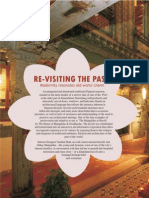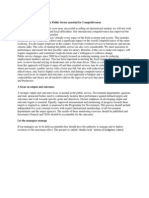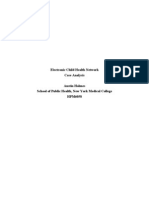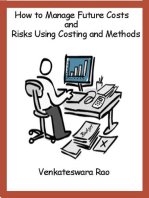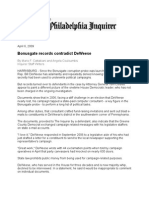CPE Tutorial (Answers) # Tut 3 at
CPE Tutorial (Answers) # Tut 3 at
Uploaded by
Christie Ann WeeCopyright:
Available Formats
CPE Tutorial (Answers) # Tut 3 at
CPE Tutorial (Answers) # Tut 3 at
Uploaded by
Christie Ann WeeOriginal Description:
Original Title
Copyright
Available Formats
Share this document
Did you find this document useful?
Is this content inappropriate?
Copyright:
Available Formats
CPE Tutorial (Answers) # Tut 3 at
CPE Tutorial (Answers) # Tut 3 at
Uploaded by
Christie Ann WeeCopyright:
Available Formats
HWA CHONG INSTITUTION
Year One H1 & H2 Economics 2010
Tutorials 1-3
Road-Map : Where are we NOW and where are we GOING
Big Ideas .Story line
A.
Scarcity ( Idea W > R )
=> Rationality ( rational choices) => Resource Allocation
Best use of scarce resources
No WASTAGE
with alternative uses.
Efficient RA (ideal) or best use
weighing O.C. against benefits before making a rational
(welfare- max) decision.
B.
Resource Allocation
1. What to produce?
2. How much to produce?
3. How to produce?
Agricultural; manufactured; services; civilian; military;
consumer; investment goods; private goods; public goods
etc
What is the ideal or optimal quantity
How to combine inputs or resources to produce the output?
(1) + (2) = AE ( allocative efficiency)
(3)
= PE ( productive efficiency)
C . MARKET MECHANISM ( martyn )
Martyn will ensure that there is AE + PE.
Important economic principle:
Right goods produces in the right quantities at the
lowest cost => AE
At the end of the day this is what economizing is ALL about !
Right => according to consumers preferences/wants.
Final outcome => Consumers welfare is maximized !
Rational choices leads to welfare-maximising outcomes.
Hurray ! 3 cheers to Martyn!
Hwa Chong Institution. All Rights Reserved. Students copy
HWA CHONG INSTITUTION
Year One H1 & H2 Economics 2010
Tutorials 1-3
TUTORIAL #3 SCARCITY, CHOICE, OPPORTUNITY COST &
PRODUCTION POSSIBILITY CURVE (1.75hrs)
At the end of the tutorial, students should be able to
Explain with illustrations the concept of opportunity cost
Discuss the need for efficient resource allocation arising from the central economic problem
of scarcity and the three basic economic problems of what, how and for whom to produce.
Define and explain the shape of and the shifts in production possibility curve
Using the PPC, explain:
o Inefficient output combinations
o Unattainable output combinations
o Graphical representation of opportunity cost
o Productive and allocative efficiency
Apply the basic concept of comparative advantage in everyday living and explain its benefits
in terms of specialisation, division of labour and exchange.
Section A: Issues & Applications
1.
Suppose you were given college education without having to pay any fees whatsoever,
are there opportunity costs involved for you?
[ NB: Economics teaches us to draw a distinction between money costs and real or
opportunity costs]
There are certainly opportunity costs even though there might be no money costs involved
for YOU.
In the sense that there must be alternative benefits that you have to forgo ( sacrificed or
give up) in order to pursue your college education in terms of giving up the ability to earn
income during that time period.
Society also bear some cost
Someone ( taxpayers) is paying for professors time, electricity for lighting etc.one
is paying for your education because you are using scarce resources buildings.
The money spent have an alternative use e.g. health-care; housing; defence.
2.
In 2004, GE changed its 100 year slogan and logo (see below). What is the opportunity
cost incurred?
Hwa Chong Institution. All Rights Reserved. Students copy
HWA CHONG INSTITUTION
Year One H1 & H2 Economics 2010
Tutorials 1-3
Resources got to be used to change GE logo. It is costly.
The opportunity costs of using resources to change GE logo may include :
Forgone benefits of using these same resources to improve GE products and/or
services
breast cancer research,
reducing carbon emissions...etc.
However, opportunity costs is not
alternative benefit forgone.
3.
ALL possible benefits forgone but the next best
What is the opportunity cost of constructing the MRT Circle Line?
The value of the next best alternative goods and services that could be produced had the
Circle Line not been constructed. It could be more HDB flats or more schools depending
on what is considered as the next best alternative use of the resources diverted to produce
the circle line. .
Again, O.C. is not simply ALL possible alternatives forgone!
Hwa Chong Institution. All Rights Reserved. Students copy
HWA CHONG INSTITUTION
Year One H1 & H2 Economics 2010
Tutorials 1-3
Section B: Structured Questions
1)
With reference to Figure 1, which point or points illustrate the following situation for Townley
Regional Health Authority
(a)
(b)
(c)
(d)
which is/are efficient?
which is/are inefficient?
of complete specialisation?
which is/are unobtainable?
Productively efficient
Productively Inefficient
A, B,C,D
Y
C, D
X
Hwa Chong Institution. All Rights Reserved. Students copy
HWA CHONG INSTITUTION
Year One H1 & H2 Economics 2010
Tutorials 1-3
i.
With reference to Figure 1, explain the trade-offs that are facing the Townley Regional
Health Authority
The PPC illustrates the concept of efficiency and opportunity costs.
Choice ( marginal versus absolute choices)
Extreme points on the PPC represents absolute choices ie either GP or dental services.
In practice such absolute choices are NOT the norm. In reality the choice is not between
GP or dental services because both are needed/wanted. The real choice is between more
GP/less Dental or vice versa. Such choices are called marginal choices.
O.C.
The shape of the PPC shows that there is a trade-off between more GP and less dental
services or vice versa. It is downward-sloping.
Starting from Point C and moving down the PPC frontier suggests that additional
units of dental services can only be attained at the expense of less and less GP
services.
Law of Increasing O.C.
Moreover the trade-off is NOT constant. In fact the trade-off or O.C. increases with
each additional unit of GP or dental service produced. The PPC is not a straightline but concave to the origin.
This is known as the law of increasing O.C. The reason is because resources such
as medical doctors are not homogeneous ie not equally efficient in producing GP
and dental services. Increasing O.C. in the production of a good is the consequence
of transferring less and less suitable resources to produce more and more of the
good in question.
Simple illustration of Law of Increasing O.C.
Dr A is a skilled doctor who is well trained as a GP and only partially/poorly trained
as a dentist.
Assume:
He can treat 100 patients a day as a GP and 1 patient a day as a dentist.
What is the O.C. of transferring Dr A from a GP to a dentist?
ii.
How can opportunity cost be used to explain the shape of Townleys PPC?
The PPC is concave because it reflects the concept of diminishing returns
or increasing opportunity cost. Every additional GP transferred to provide dental
treatment will result in more and more GP treatments sacrificed/forgone.
This is because additional units of dental treatment require the use of better and
better GPs to cross over to perform dental treatment thus incurring a higher and
higher O.C. ( or sacrifice) in terms of GP services that these doctors could have
produced.
iii. If Townley Regional Health Authority makes a more efficient use of its available resources,
how will this affect its PPC? How will the PPC be affected if they managed to get more
dentist from other counties?
Hwa Chong Institution. All Rights Reserved. Students copy
HWA CHONG INSTITUTION
Year One H1 & H2 Economics 2010
Tutorials 1-3
Moving from a point inside PPC to a point on the PPC
To make more efficient or better use of its resources means to maximise productivity out
of its existing resources.
For instance, by managing the clinic and its manpower more efficiently the same
number of doctors can treat more pat ients e.g. implement a better system that cuts
down waiting time so each doctor can see more patients per day.
In other words, TRHA must employ all its available resources to the fullest.
This is shown by a movement of point within the PPC e,g, (Y) to a point nearer to or on
the PPC e.g. (B).
PPC shift outwards
If more dentists from other countries were recruited TRHA would have
more resources or a bigger productive capacity to provide more dental
services.
Assuming dentists are occupationally mobile ie can switch to become
GP, the PPC would shift outwards. TRHA now have the capacity to
provide more of both GP and dental services enabling it to attain a
previously unattainable point such as X which lies outside the original
PPC.
PPC pivot outwards?
However, if the new dentists are occupationally immobile, the
curve would just pivot outwards along the X-axis.
PPC
Re-cap
The above exercise is to build up your skills in using the PPC as an powerful tool for economic
analysis:
(1)
Shape Illustrate scarcity and opportunity costs.
(2)
Position growth ( shifts and pivots)
(3)
Points ( output combinations) efficiency and growth.
Points inside, on and outside the frontier.
2)
Study the table below and answer the questions that follow.
Hwa Chong Institution. All Rights Reserved. Students copy
HWA CHONG INSTITUTION
Year One H1 & H2 Economics 2010
Tutorials 1-3
This new set of questions is very similar to TRHA in terms of
the application of basic concepts/principles related to the
PPC. Only the context has been changed.
You should be able to answer all of them correctly without
much difficulty. So try !
Context ( A comparison):
(4) Economy cf A health Authority
(5) 2 Goods ( rice and jeans) cf 2
services ( GP and Dental)
An economy produces only 2 goods one is a necessity good (rice) and the other a luxury
good (designer jeans). Given resources and technology, the alternative combinations of
goods of these 2 goods produced in a year are shown in the table below.
Combinations
A
B
C
D
E
F
G
Rice
21
20
18
15
11
6
0
Designer Jeans
0
1
2
3
4
5
6
(a) Calculate the opportunity costs of producing more and more units of jeans.
Jeans
Opp cost
1st
1
2nd
2
3rd
3
4th
4
5th
5
6th
6
(b) What is the above trying to illustrate regarding opportunity cost?
It is illustrating increasing opportunity cost as more and more units of jeans are produced.
(c) What causes this to happen?
Factors of production / resources are not perfectly homogeneous or equally suitable for the
production of jeans and rice.
(d) Give 2 reasons as to how an economy can produce at a point inside the PPC.
This is a sign that available resources not being used efficiently in 2 possible ways:
Hwa Chong Institution. All Rights Reserved. Students copy
HWA CHONG INSTITUTION
Year One H1 & H2 Economics 2010
Tutorials 1-3
(i) Unemployment ( unused or idling or unproductive)
(ii) Underemployment ( underused or underutilised) e.g. Resources are underused if
they are producing below their potential capacity e.g. nuclear physicists
employed as a taxi drivers
.
(e) If there is an improvement in the method of production which increases rice yield,
i) With the aid of a diagram, briefly explain how this would affect the PPC.
PPC will pivot.
The maximum amount of rice production will increase whilst the maximum
amount of jeans that can be produced will remain constant.
Rice
(i)
B
A
(ii) Point A to B
Designer Jeans
ii) Since this advancement is restricted only to rice cultivation, show on the same diagram how
might the economy bring about a simultaneous increase in the production of both goods.
By reallocating some resources from rice to jeans production. Eg. from Point A to Point B.
(f) When would the economy produce more rice without having to produce less of jeans, given
technology and resources remain unchanged?
If they are originally operating at a point inside the PPC.
Ask: 'How can the economy consume ( not the same as produce!) more
rice without having to consume less of jeans'
Ans: Through international or external trade with other countries.
This is big macroeconomic topic to be taught later.
NB:
Without access to international trade a countrys ability to consume must in principle be
limited or bounded by its ability to produce. This limitation however could be overcome
through international specialization and trade. In other words via international trade individual
countries can actually leverage on the resources of other countries ( virtually the whole world
if they are highly globalised/integrated into the world economy like SG !)
(g) (i) Use the PPC to briefly explain the difference between actual and potential growth.
Hwa Chong Institution. All Rights Reserved. Students copy
HWA CHONG INSTITUTION
Year One H1 & H2 Economics 2010
Tutorials 1-3
Actual growth:
Actual output is the output produced currently by the economy.
Actual economic growth is the increase in the current output produced by the economy.
Potential growth
Potential output is the maximum output that an economy is capable of producing. It represents
the economys productive capacity.
Potential growth is hence the increase in a countrys potential output or productive capacity.
Diagrammatically:
PPC frontier represents the countrys potential output. The growth in potential output is
therefore represented by an outward shift of the PPC frontier.
The actual output is where an economy is currently producing. It could be either inside or on a
PPC frontier. The growth in actual output could coincide ( move in tandem) with the potential
output (ideally this is called a Goldilocks economy); or it could lag behind the potential output.
In reality actual growth could even outstripped potential growth in nominal terms. This happens
when an economy is overheating.
NB:
All these concepts will be applied later in the study of macroeconomic growth theory.
So KIV Ok!
Good Y
Actual growth: e.g. a to b, b to c, c
to d
d
c
b
Ask: What happens if potential
PPCI
growth PPCII
is slower than actual
(ii) Explain whether it is always efficient if economy operates on its PPC.
a
0
2 meaning (types) of efficiency :
Good X
NB:
The generic meaning of efficiency is the absence of wastage. Its corollary is the
maximisation of Welfare or level of satisfaction. Afterall scarce resources are meant for
the production of goods and services to satisfy our wants. So if a country can get the
MOST BENEFITS out of its available resources the people must be enjoying the highest
level of welfare possible.
The bottom-line is the more efficiently resources are used the most wants can be
satisfied! Thats the goal or holy grail in the study of economics - how to hit this
objective!
Productive Efficiency (PE)
Yes.. any point on the PPC frontier indicates that the economy is using its resources
9
Hwa Chong Institution. All Rights Reserved. Students copy
HWA CHONG INSTITUTION
Year One H1 & H2 Economics 2010
Tutorials 1-3
efficiently in the PE sense. There is no waste of scarce resources in the sense that all the
resources are fully employed.
If that is the case, then all available resources are being used to produce the max output
possible right? Put in another way, every unit of output must have been produced using
the minimum or least amount of inputs or resources. This is the very essence of PE.
Example:
If 10 men ( labour) can produce a max of 10 units of output ( Pair of Jeans)
Then each pair of jean uses 1 unit of input or man to produce.
However, if labour is used inefficiently such that 10 men produces only 5 pairs of jeans,
then each pair of jean actually takes 2 men to produce right? It is productively
inefficient!
Allocative Efficiency (AE)
Depends
AE is not the same as PE. It is about whether the best combination of goods or the
output mixed is optimal?
Best => the combination that maximises the consumers or societys welfare or level of
satisfaction.
So, if the economy produces 3 pairs of jeans + 15 units of rice is this the best
combination?
It may or may not be.
It all depends on the tastes/preferences of the consumers what they like or want at a
given point of time. Taste and preferences may also change over time. Hence, all points
on the PPC are PE and at any given point of time, there can only be one particular point
that represents the best combination given the tastes/preferences prevailing at that
time.
Conclusion:
By looking at a PPC it is always possible to tell whether an economy is PE but not
necessarily whether it is AE.
In other words whilst an economy should always aim to use its available resources to the
fullest, it might not always want the SAME combination as well as SAME of goods and
services. Societys tastes and preferences change over time. New products come on
stream e.g. smartphones whilst some existing products are no longer desired e.g.
floppy diskettes.
Hwa Chong Institution. All Rights Reserved. Students copy
10
You might also like
- 4600 20180824 StatementDocument4 pages4600 20180824 StatementAnanda WijayaratnaNo ratings yet
- Manual of RegulationDocument98 pagesManual of RegulationCJ MillenaNo ratings yet
- Econ3510 Sample Final Exam WithanswersDocument10 pagesEcon3510 Sample Final Exam Withanswerssimple975No ratings yet
- ManCon - Green Valley (Final Draft)Document13 pagesManCon - Green Valley (Final Draft)Jerome Luna Tarranza100% (1)
- Adv Health Economics Module - 2014 2015Document14 pagesAdv Health Economics Module - 2014 2015Matet Sales Asuncion75% (4)
- Eco 101 Lecture 1-3 IntroductionDocument10 pagesEco 101 Lecture 1-3 IntroductionSanaullah SiddiqueNo ratings yet
- Tut 23 - Part 3 EssaysDocument41 pagesTut 23 - Part 3 EssaysChristie Ann WeeNo ratings yet
- Tut 22 AnswersDocument53 pagesTut 22 AnswersChristie Ann Wee100% (1)
- Tut # 6 (Answers)Document39 pagesTut # 6 (Answers)Christie Ann WeeNo ratings yet
- Mangaldas HaveliDocument6 pagesMangaldas Havelisanghviriddhi83% (6)
- Ib Economics: 1.3 Production Possibility CurvesDocument30 pagesIb Economics: 1.3 Production Possibility CurvesAlexander Van TilNo ratings yet
- PPC and Effect on PPC due to Various Government Policies (1)Document4 pagesPPC and Effect on PPC due to Various Government Policies (1)Avika JindalNo ratings yet
- Chris EcosDocument5 pagesChris EcoschristopherstuartfidlerNo ratings yet
- IEO Economics Open Solutions 2023Document11 pagesIEO Economics Open Solutions 2023anapiaaatregNo ratings yet
- BSECO PrntableDocument4 pagesBSECO PrntableSumair IqbalNo ratings yet
- The Government Expenditure Efficiency Towards The Human DevelopmentDocument8 pagesThe Government Expenditure Efficiency Towards The Human Developmentakita_1610No ratings yet
- Basic Economics ConceptDocument6 pagesBasic Economics ConceptAnsh MidhaNo ratings yet
- PPC and Effect on PPC due to Various Government Policies (2)Document3 pagesPPC and Effect on PPC due to Various Government Policies (2)Avika JindalNo ratings yet
- Managerial EconomicsDocument9 pagesManagerial EconomicsAbhishek ModakNo ratings yet
- "Mag-Ekonomiya Ka Naman, May Pandemic Pa Naman Ngayon." "There Is Enough For One's Need But Not For Anyone's Greed."Document13 pages"Mag-Ekonomiya Ka Naman, May Pandemic Pa Naman Ngayon." "There Is Enough For One's Need But Not For Anyone's Greed."Nour Aira NaoNo ratings yet
- Sunday Business Post Jan 2012 Real Structural Reform of The Public Sector Essential For CompetitivenessDocument3 pagesSunday Business Post Jan 2012 Real Structural Reform of The Public Sector Essential For CompetitivenessDonThornhillNo ratings yet
- What Is Economics About? Part OneDocument14 pagesWhat Is Economics About? Part Onesaqib razaNo ratings yet
- ECON1000 Past Paper QuestionsDocument24 pagesECON1000 Past Paper QuestionsOjbrownNo ratings yet
- Economics Lecture Notes - Chapter 1 - Economics CafeDocument8 pagesEconomics Lecture Notes - Chapter 1 - Economics CafebobfooNo ratings yet
- Full download Economics Principles Applications and Tools Global Edition 9th Edition OSullivan Solutions Manual pdf docxDocument48 pagesFull download Economics Principles Applications and Tools Global Edition 9th Edition OSullivan Solutions Manual pdf docxberkyanedin100% (1)
- Week 1Document4 pagesWeek 1Anubhav SinghNo ratings yet
- Igcse Economics Hand OutDocument23 pagesIgcse Economics Hand Outvincentmdala19No ratings yet
- Long-Term Objectives, Strategic Analysis and ChoiceDocument10 pagesLong-Term Objectives, Strategic Analysis and ChoiceatifpfizerNo ratings yet
- AS ECONOMICS unit 1Document14 pagesAS ECONOMICS unit 1Rimsha NadeemNo ratings yet
- CostsDocument30 pagesCostsmazharmuhammadumair189No ratings yet
- 2010Chpt1 AnswersDocument12 pages2010Chpt1 AnswersSabrina DelgadoNo ratings yet
- Backing - The - Future - Commissioning Children Services For Better Outcomes 2009Document16 pagesBacking - The - Future - Commissioning Children Services For Better Outcomes 2009afamailNo ratings yet
- Chapter 1 Reading Outline: Name: Luis Anthony Villanes AlcantaraDocument4 pagesChapter 1 Reading Outline: Name: Luis Anthony Villanes AlcantaraLuisNo ratings yet
- Chapter 1 The Central Problem of Economics and Economic SystemDocument11 pagesChapter 1 The Central Problem of Economics and Economic SystemcsanjeevanNo ratings yet
- Bcog 171Document17 pagesBcog 171icaibosinterNo ratings yet
- Managerial EconomicsDocument19 pagesManagerial Economicswissam.bwNo ratings yet
- ECONOMICSDocument9 pagesECONOMICSJuma claudeNo ratings yet
- Electronic Child Health Network Case Analysis Austin Holmes School of Public Health, New York Medical College HPM6058Document6 pagesElectronic Child Health Network Case Analysis Austin Holmes School of Public Health, New York Medical College HPM6058aholmes172No ratings yet
- Department of Economics Working Paper Series: Data Envelopment Analysis For Performance Evaluation: A Child's GuideDocument52 pagesDepartment of Economics Working Paper Series: Data Envelopment Analysis For Performance Evaluation: A Child's GuideAvtansh GhaiNo ratings yet
- Preguntas ITAM 1Document3 pagesPreguntas ITAM 1ashleyarana.a44No ratings yet
- Section 1-Basic Economic Problem: (Answers For Textbook Questions)Document5 pagesSection 1-Basic Economic Problem: (Answers For Textbook Questions)ailsa.elsa.booNo ratings yet
- Thesis Topics Energy EconomicsDocument5 pagesThesis Topics Energy Economicsveronicaperezvirginiabeach100% (2)
- IGCSE Economics (Summary Updated)Document91 pagesIGCSE Economics (Summary Updated)CRITICAL GAMERNo ratings yet
- Economics NotesDocument239 pagesEconomics NotesNonzwakazi MadyibiNo ratings yet
- The Macro Economy: Ideas For Answers To Progress QuestionsDocument8 pagesThe Macro Economy: Ideas For Answers To Progress QuestionsChristy NyenesNo ratings yet
- Introduction To Economics, PPF & Economic SystemsDocument44 pagesIntroduction To Economics, PPF & Economic SystemsKwongKHNo ratings yet
- Final15 SolDocument7 pagesFinal15 SolStowe EighmyNo ratings yet
- Assignment Guidelines by The Teacher: Salman Ahmed KhanDocument3 pagesAssignment Guidelines by The Teacher: Salman Ahmed KhanHafsah JavedNo ratings yet
- IB Economics Standard Level DP1 Practice Exam QuestionsDocument13 pagesIB Economics Standard Level DP1 Practice Exam QuestionsJohn GoudaertsNo ratings yet
- Module 1 EconomicDocument8 pagesModule 1 EconomicCatherine M. MaquiringNo ratings yet
- Eco105 MidtermsDocument5 pagesEco105 MidtermsAngelu GuardianNo ratings yet
- Assignment No Economics)Document40 pagesAssignment No Economics)naseem208No ratings yet
- 885Document47 pages885gollopqiiNo ratings yet
- Economics For Today 5th Edition Layton Solutions ManualDocument12 pagesEconomics For Today 5th Edition Layton Solutions Manualmarybaileykfqyrzbpei100% (9)
- Be - Notes 1Document5 pagesBe - Notes 1AnanyaNo ratings yet
- GBMT1006 Operations Management Test 1Document5 pagesGBMT1006 Operations Management Test 1shrey barotNo ratings yet
- Hyman 10e IM TB Ch02Document9 pagesHyman 10e IM TB Ch02john brownNo ratings yet
- National Health Service Organisational and Management Issues February 20101Document5 pagesNational Health Service Organisational and Management Issues February 20101Brian FisherNo ratings yet
- Telemdicine BusinessDocument12 pagesTelemdicine BusinessfreteerNo ratings yet
- Submitted By: Biki Das Class - XI Stream - Commerce Roll No. - 5Document42 pagesSubmitted By: Biki Das Class - XI Stream - Commerce Roll No. - 5Biki DasNo ratings yet
- The Nature of The Economic ProblemDocument118 pagesThe Nature of The Economic ProblemYashwinni VijayasekarNo ratings yet
- Full Syllabus ECONOMICS XII CBSEDocument231 pagesFull Syllabus ECONOMICS XII CBSEShubdhi94100% (1)
- Health Economics 2Document71 pagesHealth Economics 2NICHOLAS KAUMBANo ratings yet
- How to Manage Future Costs and Risks Using Costing and MethodsFrom EverandHow to Manage Future Costs and Risks Using Costing and MethodsNo ratings yet
- Lean Healthcare: Enhancing the Patient Care Process while Eliminating Waste and Lowering CostsFrom EverandLean Healthcare: Enhancing the Patient Care Process while Eliminating Waste and Lowering CostsRating: 5 out of 5 stars5/5 (2)
- Tutorial 23 - Section F (Case Studies)Document43 pagesTutorial 23 - Section F (Case Studies)Christie Ann WeeNo ratings yet
- Tutorial 8Document17 pagesTutorial 8Christie Ann WeeNo ratings yet
- Tut 16-18 - Case Study (PJC & VJC) - Revised by DavidDocument19 pagesTut 16-18 - Case Study (PJC & VJC) - Revised by DavidChristie Ann WeeNo ratings yet
- Tut #19 - BOP (Answers)Document10 pagesTut #19 - BOP (Answers)Christie Ann WeeNo ratings yet
- Tut #21 - International Trade (Answers) - No CSQDocument47 pagesTut #21 - International Trade (Answers) - No CSQChristie Ann WeeNo ratings yet
- Market Failure Term 1Document24 pagesMarket Failure Term 1Christie Ann WeeNo ratings yet
- Schubert EssayDocument2 pagesSchubert EssayChristie Ann WeeNo ratings yet
- 2010 Issue 2 PDFDocument76 pages2010 Issue 2 PDFmatthewksharma100% (2)
- Compiled Final Draft of Chapter 1 To 3 IlotDocument58 pagesCompiled Final Draft of Chapter 1 To 3 IlotAnjo SemaniaNo ratings yet
- Rieta Vs People DigestDocument1 pageRieta Vs People Digestminri721No ratings yet
- Disbursing Officer IPCRF and CashierDocument4 pagesDisbursing Officer IPCRF and CashierAlpha OneNo ratings yet
- Analogy - Pirlyn Petallar PPSDocument31 pagesAnalogy - Pirlyn Petallar PPSPirlyn PetallarNo ratings yet
- Texspin - New MRP List.Document38 pagesTexspin - New MRP List.Gourav Agarwal78% (18)
- Zara Case Analysis Operations Management MBM1110Document8 pagesZara Case Analysis Operations Management MBM1110MacMehta100% (1)
- Articles of AssociationDocument38 pagesArticles of AssociationJuStine LimNo ratings yet
- Algeria TemplatesDocument19 pagesAlgeria TemplatesADrian ZeeGreatNo ratings yet
- 2023-07 The ConnexionDocument64 pages2023-07 The ConnexionleporeNo ratings yet
- Captura 2023-01-20 A Las 15.09.29Document1 pageCaptura 2023-01-20 A Las 15.09.29Iñigo CastreNo ratings yet
- Group 3 Case Study - Nestle's Growth StrategyDocument11 pagesGroup 3 Case Study - Nestle's Growth StrategyEryll100% (1)
- Identifying Market Segments and Targets (Chapter 7)Document15 pagesIdentifying Market Segments and Targets (Chapter 7)sundus syedNo ratings yet
- NEP2020 - Science - FYUG - Model - Structure - KBCNMU - 20 March 2024Document6 pagesNEP2020 - Science - FYUG - Model - Structure - KBCNMU - 20 March 2024PrincipalNo ratings yet
- Carmignani 2005Document39 pagesCarmignani 2005skavi_2702No ratings yet
- Curriculum in Japan: Learning Chinese CharactersDocument21 pagesCurriculum in Japan: Learning Chinese CharactersjolinaNo ratings yet
- ST Osyth Church of England School TERM DATES 2018/2019: M T W TH F Sa Su September October November DecemberDocument1 pageST Osyth Church of England School TERM DATES 2018/2019: M T W TH F Sa Su September October November DecemberShNo ratings yet
- Inventario de SofwareDocument23 pagesInventario de SofwareKelly Johanna BARRERA ORDONEZNo ratings yet
- Inquirer 20090406Document4 pagesInquirer 20090406Signor FerrariNo ratings yet
- Revised - TATA Product Deck - Sales Training For Customers18AugDocument8 pagesRevised - TATA Product Deck - Sales Training For Customers18AugVipin K GuptaNo ratings yet
- Basic Principles CommitteeDocument1 pageBasic Principles CommitteeAbbasi WaqarNo ratings yet
- Faysal Bank VoucherDocument1 pageFaysal Bank VoucherAliNo ratings yet
- Word FormationDocument3 pagesWord FormationPhượng T.K. NguyễnNo ratings yet
- Pico HydroDocument9 pagesPico HydrodishkuNo ratings yet
- NGOs CoordinatorDocument5 pagesNGOs CoordinatorApplication PurposeNo ratings yet
- Tutorial 2 Create A One-Page Telephone Conversation With A Partner. The Conversation/dialogue Can Be On Any Topic in A Variety of SettingsDocument2 pagesTutorial 2 Create A One-Page Telephone Conversation With A Partner. The Conversation/dialogue Can Be On Any Topic in A Variety of SettingsNadiah SakeriNo ratings yet
- Research 111 FinalDocument38 pagesResearch 111 FinalGweneth AnunciadoNo ratings yet
- Curriculum Vitae Of: Md. Arifur Rahman TusharDocument2 pagesCurriculum Vitae Of: Md. Arifur Rahman TusharHmh Alam ChowdhuryNo ratings yet










